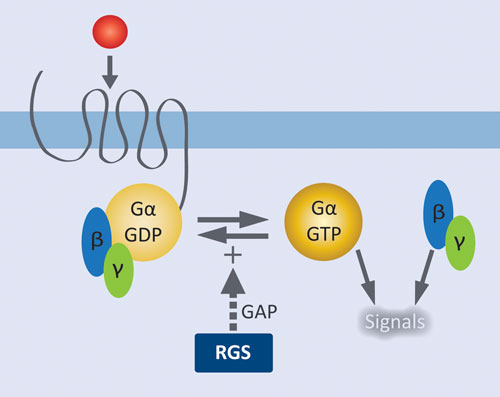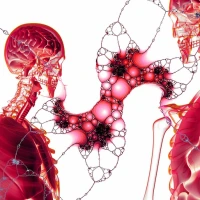In this lesson, we explore the nervous system and share notes as part of the study guide series. We will explore the awesome brain and nerves! Topics include Biosignaling, Membrane Receptors, Signal Transduction, Ligand Gated Ion Channels vs G Protein Coupled Receptors vs Enzyme Linked Receptors
Check out our popular nervous system notes.

Membrane Receptors
- Membrane receptors = integral proteins that interact with outside environment
- Signaling molecules (aka ligands) such as neurotransmitters, hormones, etc. bind to the membrane receptor (with specificity) and make a ligand-receptor complex.
- This complex then triggers a response in the cell.
- This process explains how hormones function, how / when cells divide, when they die, etc. Also explains how cells communicate with each other
- Membrane receptors are a common target for pharmaceutical drugs; this is why some cells can target specific cells (like your liver or heart)
- Signal transduction — an extracellular signal molecule (ligand) binds to membrane receptor, which then triggers an intracellular response
- The binding causes conformational change in the protein, which induces other changes that eventually lead to a cascade of signals in the cell, trigger a specific response.
- Each receptor can only bind with specific / certain types of molecules. This is especially important in hormonal signaling.
- Used to be called lock-and-key, but induced fit is now the model, which means the ligand and receptor can change shape to better fit one another.
- Three main types of membrane receptors:
- Ligand gated ion channels
- G-protein coupled receptors
- Enzyme linked receptors
Ligand Gated Ion Channels

- Also called ion channel linked receptors, these are transmembrane ion channels that open or close in response to the binding of a ligand.
- Commonly found in excitable cells like neurons, because these channels react quickly to binding of a ligand, and thus the cells can respond quickly to a stimulus.
- Only specific ligands can bind to specific channels (lock and key / induced fit)
- Note that the binding site of a ligand is not in/on the actual ion channel… the ligand binds to allosteric site on the receptor, and causes opening / closing of the channel by conformational change.
- The receptor allosteric binding site can also be inside the cell, but that’s rare.
- It’s also possible for there to be multiple binding sites for ligands.
- Once the ions move in or out of the cell, an intracellular electrical signal happens
- Ligand gated ion channels are not the same as voltage gated ion channels.. those only depend on a different in membrane potential, not the binding of a ligand
- Ligand gated ion channels are also different from stretch activated ion channels.. which open / close in response to deformation or stretching of the cell membrane.
- Generally, ligands are not directly involved in any aspect of intracellular signaling.
- Ligands do not directly influence the production of cyclic AMP and do not hydrolyze GTP to GDP.
- A ligand is a small molecule, usually a protein, that binds to a membrane-bound receptor, which triggers downstream changes within the cell.
- A molecule that attaches to a receptor, triggering changes within the cell is the correct answer.
- Cells that respond to mechanic forces typically possess stretch-activated ion channels. An example would be a cardiac cell.
- Terminally differentiated cells comprise multiple cell types, some of which may possess ion channels, but this is not the best choice here.
- The importance of the ligand-gated ion channel is that it allows for rapid response to a stimulus, so cells that need to respond quickly (like neurons) are those that possess ligand-gated ion channels.
- Cells that need to respond quickly to external stimuli is the correct answer.
- Allosteric binding is an important feature of ligand-gated ion channels.
- Ligand-gated ion channels actually can have intracellular binding sites. React quickly to stimuli or ligand
G-Protein Coupled Receptors

- Only found in eukaryotes; are the largest class of membrane receptors. Each has a specific function
- Ligands that bind to these range from light sensitive compounds to pheromones, hormones, neurotransmitters, etc.
- GCPRs can regulate immune system, growth, sense of smell / taste / behavioral / visual and our moods. Many G-proteins and GCPRs still have unknown functions.
- Most important characteristics:
- GCPRs have 7 transmembrane alpha helices.
- They’re also linked to G-proteins, which have the ability to bind to GTP / GDP and be activated
- G-proteins have 3 subunits: Gα, Gß, and Gγ. Gα and Gγ are attached by lipid anchors.
(1) When the ligand binds to the GCPR, it undergoes a conformational change.
(2) Because of the conformational change, the Gα exchanges its GDP for a GTP, becoming activated.
(3) The GTP causes the Gα subunit to dissociate and move away from Gßγ dimer.
(4) Gα subunit then goes on to regulate target proteins
(5) Target protein then relays signal via second messenger.
- So target protein could be an enzyme that produces second messengers (e.g. adenylase making cAMP), or an ion channel that lets ions be second messengers
- Some G-proteins stimulate activity, others inhibit.
- This chain of events, with a Gα protein subunit dissociating and going on to activate further response in the cell, will happen repeatedly as long as the ligand is bound. So how do we turn it off?
(6) GTP on the Gα is hydrolyzed to GDP
- This often occurs internally, by GTPase
within the Gα–protein itself, but can also
be regulated (accelerated) by RGS protein - Ex with epinephrine (aka adrenaline):
- Epi binds to ß-adrenergic receptor (GCPR),
which causes it to undergo conformational
change and switch GDP to GTP on the Gα
subunit of the G-protein.
- The Gα subunit dissociates and binds to adenylate cyclase, which then makes the secondary messenger cAMP from AMP.
- cAMP goes on to increase heart rate, dilate blood vessels, and break down glycogen —> glucose
- Epi binds to ß-adrenergic receptor (GCPR),
Enzyme Linked Receptors (aka catalytic receptors)
- Enzyme-linked receptors are transmembrane proteins that uniquely function as receptors for signaling molecules and enzymes — binding of ligand activates enzymatic activity.
- General structure includes extracellular “ligand binding domain” and intracellular “enzymatic domain”
- Shaped sort of like a Y (the V part is extracellular, where ligand binds)
- Most common enzyme linked receptors are tyrosine kinases (also called RTKs), which regulate cell growth differentiation and survival; and they can bind and respond to ligands such as growth factors.
- Unique because Tyrosine is on the enzymatic intracellular receptor.
- RTKs have ability to transfer phosphate groups to intracellular proteins, which activates them, and they go on to trigger additional change.
- RTKs occur in pairs. When ligands bind, the RTKs come together and act together in a cross-linked dimer. This helps activate the Tyr phosphorylation activity.
- Each Tyrosine in one dimer activates a Tyrosine on the other dimer! This is cross phosphorylation.
- Tyr causes an ATP —> ADP + Pi
- Other Tyr then pick up the free phosphate group.
- Once activated, these phosphorylated Tyr allow different proteins to come by and attach themselves to them.
- The only thing these proteins need to dock is an SH2 domain, which allows them to bind.
- Multiple docking of different proteins allows changes to multiple different intracellular signaling pathways at the same time.
- The cellular changes often end at nucleus, signal from docking protein affecting transcription.
- RTKs are useful / famous for their role in growth factors, such as in regulating surface proteins called epinephrines, which can guide developmental processes in tissue architecture, placement of nerve endings, and blood vessel maturation. Other growth factors (like platelet derived) and hormones (such as insulin) also bind to RTKs.
- When the RTKs fail to regulate properly, they can cause issues in cell growth and differentiation. Many cancers involve mutations of RTKs
- Many chemotherapies thus target RTKs. For example, the breast cancer drug Herceptin binds to and inhibit an RTK that is overexpressed in many breast cancers.
RTKs are often associated with growth factors.

Check out our popular nervous system lesson plan articles!
Central Chemoreceptor vs Peripheral Chemoreceptor
Check out these popular articles 🙂
Circulatory System: Blood Flow Pathway Through the Heart
Ectoderm vs Endoderm vs Mesoderm
Circulatory System: Heart Structures and Functions
Ductus Arteriosus Vs Ductus Venosus Vs Foramen Ovale: Fetal Heart Circulation
Cardiac Arrhythmias: Definition, Types, Symptoms, and Prevention
Upper Vs Lower Respiratory System: Upper vs Lower Respiratory Tract Infections
Seven General Functions of the Respiratory System
Digestive System Anatomy: Diagram, Organs, Structures, and Functions
Kidney Embryology & Development: Easy Lesson
Psychology 101: Crowd Psychology and The Theory of Gustave Le Bon
Introduction to Evolution: Charles Darwin and Alfred Russel Wallace
Copyright © 2022 Moosmosis Organization: All Rights Reserved
All rights reserved. This essay first published on moosmosis.org or any portion thereof may not be reproduced or used in any manner whatsoever
without the express written permission of the publisher at moosmosis.org.

Please Like and Subscribe to our Email List at moosmosis.org, Facebook, Twitter, Youtube to support our open-access youth education initiatives! 🙂
Categories: anatomy, Biology, cell biology, education, health, medicine, stem, technology














Awesome posts!
LikeLiked by 2 people
Thank you!
LikeLike
fantastic biomedical content!
LikeLiked by 2 people
Thank you, K Stevenson! Glad you enjoyed our biomedical content!
LikeLiked by 1 person